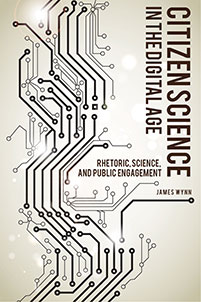Citizen Science in the Digital Age: Rhetoric, Science and Public Engagement
 The tsunami had receded just days before. The cores of three reactors at the Fukushima Daiichi nuclear power plant on Japan’s central east coast were molten wrecks. The deadly radiation once bottled inside their concrete containment domes -- well, nobody knew exactly where it went.
The tsunami had receded just days before. The cores of three reactors at the Fukushima Daiichi nuclear power plant on Japan’s central east coast were molten wrecks. The deadly radiation once bottled inside their concrete containment domes -- well, nobody knew exactly where it went.
So a group of citizens decided to find out.
The years-long nationwide act of citizen science that followed armed Japan’s citizenry with information never before publicly available, and forced the country’s government and institutions to adapt to a political reality unthinkable just a few years earlier. Their story is one of three examples of the diffusion of scientific research explored in "Citizen Science in the Digital Age: Rhetoric, Science and Public Engagement," a new book by Carnegie Mellon University’s James Wynn.
Citizen science is not a new concept. The Smithsonian Institute relied on the practice to gather data for a weather project in the mid-1800s. But the digital age has vastly expanded its potential and usefulness.
Wynn’s book explores how this practice is changing the arguments that steer public policy by raising awareness about risk. If risk data are no longer the sole province of scientific institutions and governments, if the information is gathered and held by the public, that "changes the way people can argue," said Wynn, associate professor of English and rhetoric in the Dietrich College of Humanities and Social Sciences.
Take Safecast, the effort by Japanese citizens to use homemade Geiger counters to record radiation readings around the country, and display that information in an online map.
"If you don’t have data, and the government is the only source of data, they’re the ones who choose how that data is displayed, they get to choose who gets that data, they get to choose how that data is characterized and framed," Wynn said.
Safecast volunteers gave people a far more detailed picture of the accident’s aftermath, and discovered that the government had been ignoring two types of radiation that posed serious dangers to humans if ingested.
But citizen science is not always an unambiguous benefit. Two other cases Wynn explored — a climate science investigation in the United States and a sound-mapping project in London — showed how ideological or political motives can influence public debate.
Anthony Watts, a TV weatherman and skeptic of anthropogenic climate change, teamed up with a University of Colorado climatologist to photograph the locations of government temperature monitors. Watts and other citizen scientists involved in the project found monitors in places which would artificially increase temperature measurements, including in front of an air conditioner exhausts and near parking lots. One was even photographed beside a fire barrel. Watts cited the photos as evidence challenging global warming in a paper he wrote for the conservative Heartland Institute.
But scientists, who statistically corrected the data from sites around the country based on the siting information, found the monitors collectively actually returned cooler average temperatures overall.
"You see pictures like (the ones Watts saw) and you think, 'What do you mean "cold bias?"' But these represent in total maybe a hundred sites or less than 10 percent of the 1,221 sites," Wynn said. "So how does this get used in an argument? 'Well, the government is obviously covering it up because look at this one monitoring site near a fire barrel.'"
In London, an effort to use residents to document the noise made by a scrapyard turned out to be the brainchild of the city councilwoman who represented the borough — and who wanted to turn the land into housing to reap the rewards of the city’s booming real estate market.
"The people were sort of co-opted as a way of making a political case for the removal of the scrapyard," Wynn said.
And rather than relying on the data gathered by her constituents, she used it as the pretext for hiring a professional firm to repeat their work and strengthen her case.
John Lyne, director of graduate studies for the communications department at the University of Pittsburgh, said that the book "hits a sweet spot between sociological and rhetorical studies of science."
"Citizen Science in the Digital Age" was published by The University of Alabama Press.